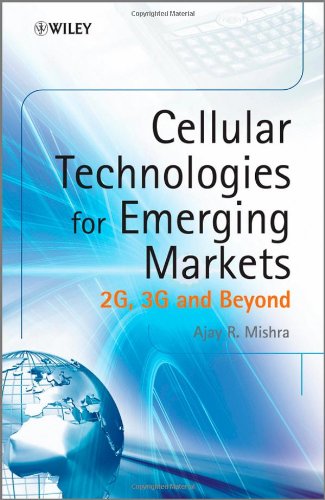

Most ebook files are in PDF format, so you can easily read them using various software such as Foxit Reader or directly on the Google Chrome browser.
Some ebook files are released by publishers in other formats such as .awz, .mobi, .epub, .fb2, etc. You may need to install specific software to read these formats on mobile/PC, such as Calibre.
Please read the tutorial at this link. https://ebooknice.com/page/post?id=faq
We offer FREE conversion to the popular formats you request; however, this may take some time. Therefore, right after payment, please email us, and we will try to provide the service as quickly as possible.
For some exceptional file formats or broken links (if any), please refrain from opening any disputes. Instead, email us first, and we will try to assist within a maximum of 6 hours.
EbookNice Team

Status:
Available5.0
10 reviews
ISBN-10 : 0470666242
ISBN-13 : 9780470666241
Author: Ajay R. Mishra
In this book, the author addresses technologies that are being used in emerging cellular markets. These include GSM/EGPRS and CDMA which are being deployed at a rapid pace, while technologies such as UMTS (3G)/ HSPA (3.5G) which have started to find a place in these high growth markets, are also considered. The book examines other technologies including LTE (3.9G) which have already moved out of research labs into the commercial world. 2G-CDMA is widely used, while further developments, e.g. CDMA2000 are also finding acceptance in the commercial arena. IMS/Convergence is increasingly popular all over the world; UMA, which is deployed mostly in North America; and DVB which is gaining worldwide popularity, especially in South Asia, are all reviewed.
1 Cellular Technology in Emerging Markets 1
1.1 Introduction 1
1.2 ICT in Emerging Markets 1
1.3 Cellular Technologies 5
1.4 Overview of Some Key Technologies 7
1.5 Future Direction 14
2 GSM and EGPRS 15
2.1 Introduction 15
2.2 GSM Technology 16
2.3 Network Planning in the GSM Network 25
2.4 EGPRS Technology 44
2.5 EGPRS Network Design and Optimization 50
3 UMTS 55
3.1 The 3G Evolution – UMTS 55
3.2 UMTS Services and Applications 57
3.3 UMTS Bearer Service QoS Parameters 59
3.4 QoS Classes 60
3.5 WCDMA Concepts 62
3.6 ATM 68
3.7 Protocol Stack 76
3.8 WCDMA Network Architecture – Radio and Core 77
3.9 Network Planning in 3G 81
3.10 Network Optimization 89
4 CDMA 95
4.1 Introduction to CDMA 95
4.2 CDMA: Code Division Multiple Access 96
4.3 Spread Spectrum Technique 98
4.3.1 Direct Sequence CDMA 98
4.3.2 Frequency Hopping CDMA 100
4.3.3 Time Hopping CDMA 100
4.4 Codes in CDMA System 100
4.4.1 Walsh Codes 100
4.4.2 PN Codes 101
4.5 Link Structure 102
4.5.1 Forward Link 102
4.5.2 Reverse Link 102
4.6 Radio Resource Management 103
4.6.1 Call Processing 103
4.6.2 Power Control 105
4.6.3 Handoff 107
4.7 Planning a CDMA Network 107
4.7.1 Capacity Planning 107
4.7.2 Parameters in a CDMA Network 109
4.8 CDMA 2000 111
4.9 TD-SCDMA 119
5 HSPA and LTE 125
5.1 HSPA (High Speed Packet Access) 125
5.2 HSDPA Technology 125
5.3 HSDPA Channels 129
5.4 Dimensioning in HSDPA 130
5.5 Radio Resource Management in HSDPA 131
5.6 High Speed Uplink Packet Access (HSUPA) 135
5.7 HSUPA Channels 136
5.8 HSUPA Radio Resource Management 138
5.9 HSPA Network Dimensioning 139
5.10 LTE (Long Term Evolution) 141
5.11 LTE Technology 143
5.12 Radio Resource Management 149
5.13 Security in LTE 149
6 OFDM and All-IP 153
6.1 Introduction to OFDM 153
6.2 OFDM Principles 155
6.3 MIMO Technology 159
6.4 OFDM System 161
6.5 Design of OFDM Channel 163
6.6 Multi-User OFDM Environment 163
6.7 All-IP Networks 164
6.8 Architecture of All-IP Networks 169
7 Broadband Wireless Access: WLAN, Wi-Fi and WiMAX 173
7.1 Wireless Technology Differentiation 173
7.2 Wireless LAN 176
7.3 Wi-Fi Networks 181
7.4 WiMAX Networks 183
8 Convergence and IP Multimedia Sub-System 201
8.1 Introduction to Convergence 201
8.2 Key Aspects of Convergent Systems 202
8.3 Architecture in Convergent Networks 207
8.4 IMS 209
8.5 IMS Architecture 211
8.6 IMS Security System 222
8.7 IMS Charging 223
8.8 Service Provisioning in IMS 224
9 Unlicensed Mobile Access 229
9.1 Introduction to UMA 229
9.2 Working on UMA Network 230
9.3 Architecture of UMA 231
9.4 Up Interface in UMA 233
9.5 Protocols in UMA 234
9.6 Security Mechanism of UMA 235
9.7 Identifiers and Cell Identifiers in UMA 235
9.8 Mode and PLMN Selection 236
9.9 UMAN Discovery and Registration Procedures 237
9.10 UNC Blocks 242
9.11 Comparison between Femtocells and UMA 243
9.12 Conclusion 243
10 DVB-H 245
10.1 Mobile Television 245
10.2 Introduction to DVB 247
10.3 DVB-H Ecosystem 249
10.4 DVB-H System Technology 250
10.5 DVB-H Network Architecture 256
10.6 DVB-H Network Topologies 257
10.7 Network Design in the DVB-H Network 258
Appendix A VAS Applications 265
A.1 Multimedia Messaging Service 265
A.2 Push-to-Talk over Cellular 267
A.3 Streaming Service 270
A.4 Short Message Service 271
A.5 Wireless Application Protocol 272
Appendix B Energy in Telecommunications 275
B.1 The Solution Exists – But It’s Not Very Good 275
B.2 Renewable Energy – a Better Solution 276
B.3 The Optimal Design for a Base Station Site 279
B.4 Business Case for Renewable Energy in Mobile Base Station Sites 279
B.5 Effects of Climate Change on Mobile Networks 281
Bibliography 283
Index 291
how many days were in the roman calendar
how did the roman calendar work
the roman calendar facts
the roman calendar
the roman calendar invented
Tags: Cellular Technologies, Emerging Markets, Beyond, Ajay Mishra